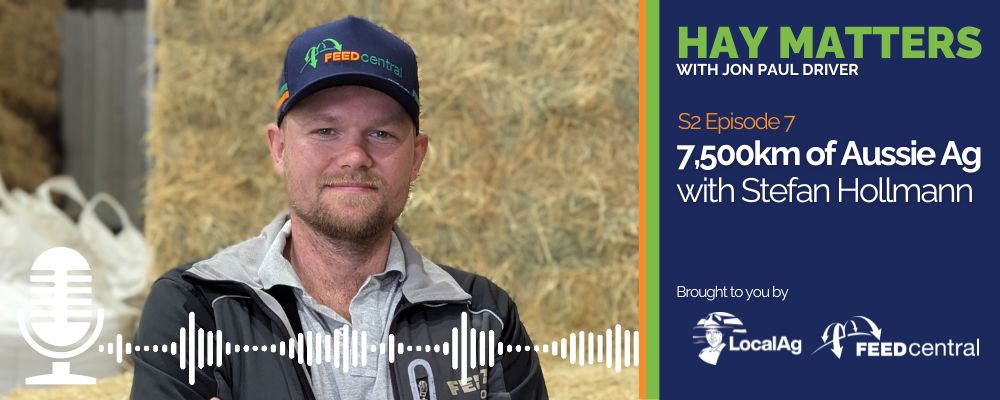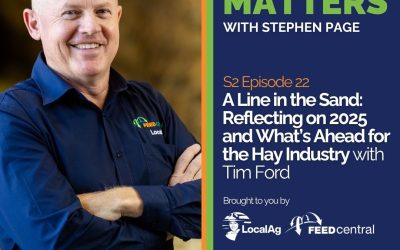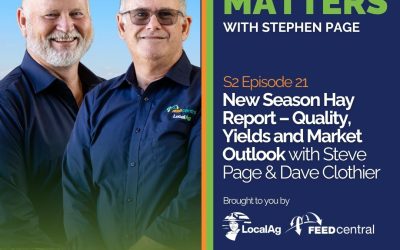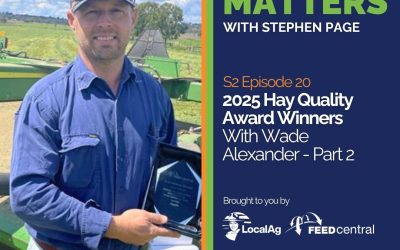
Podcast Highlights
In the latest Hay Matters Podcast brought to you by LocalAg and Feed Central, host Jon Paul Driver catches up with Stefan Hollmann, a German-born machinery operator and high-density baling expert based in South Australia. After arriving for one harvest, Stefan stayed on and has since produced over 100,000 bales across eight years with the Schusters. He reflected on his recent 7,500-kilometre trip across the east coast, sharing insights on seasonal variability, farming practices, and why understanding feed quality matters more than ever.
- Seasonal contrasts were striking, with some regions flooded, others in deep drought – highlighting the need for localised decision-making and adaptable farming strategies.
- Visiting operations from cotton to corn to rice in a single day highlighted the diversity and complexity of Australian agriculture.
- Farmers are experimenting with seeding tech, chemical timing, and soil improvement methods like delving and spading; Stefan noted there’s no one-size-fits-all approach, even among similar farms.
- A visit to Feed Central’s Toowoomba lab shifted Stefan’s perspective on hay analysis, seeing first-hand the precision behind NIR testing and the variety of fodder types tested nationally.
- Coming from Germany’s dairy sector, Stefan values knowing the nutritional content of feed, and believes Australian producers could benefit more from NIR testing, not just visual inspection.
- The trip reinforced how much producers can learn by stepping outside their own patch. Conversations with other farmers sparked ideas he’s keen to explore back home.
Read Transcript
Jon Paul Driver 0:05
Welcome to the Hay Matters podcast brought to you by LocalAg and Feed Central. This is your go to source for all things hay related in Australia. I’m your host, Jon Paul Driver, and in today’s episode, we’re joined by Stefan Hollmann. Stefan works for the Schuster family in Freeling, South Australia. I had the pleasure of meeting Stefan and the Schusterswhen I was touring around there. I highly recommend the barns at Freeling if you need an Event Centre or a really nice, an exceptionally nice, grain silo to stay in. They were so hospitable. It was a wonderful time there. Stefan has worked there for eight years. Stefan, you just took a holiday around Australia. Where did you go?
Stefan Hollmann 0:47
Yes, I did. We went from Freeling all the way up to Airlie Beach, and then basically drove all the way back down, or did around seven and a half thousand kilometres of driving.
Jon Paul Driver 1:00
That’s that’s a lot. I think you take holidays, the way that I take holidays going from farm to farm to farm.
Stefan Hollmann 1:08
It’s, yeah, most of the time it ends up being a combination of in between, yeah, sort of farming to calling in on different properties, and doing a little bit of going to the beach and going to the pub and stuff like that. But yeah, it’s, it’s usually a good mix.
Jon Paul Driver 1:27
Now, what are, what are some of the stops that you made?
Stefan Hollmann 1:29
Well, we saw lots of different farms, obviously different country sides. I had my mate with me from Germany, so everything was, well, it wasn’t completely new for him, because he has been in Australia before, when he was working with John Deere, the biggest mind blowing thing was just to see these different country sites, and going from very dry to really wet and no feed to lots of feed, and talking to lots of different farmers with good ideas, new ideas. And it was like a school trip as well, because we learn a lot of things as well just by listening to different farmers with different ideas and different companies we visited. So, yeah, was very nice.
Jon Paul Driver 2:08
Now, you did stop by Feed Central and got to tour their lab.
Stefan Hollmann 2:12
Yes, we did, because we’ve been dealing with them for years, or how many years that they started trading with them through before I came to the Schusters, so, and I’ve known them since, or we had to go to Toowoomba anyway, because we’re using, like, a grain analyser from a company which is trading out of Toowoomba as well. And then I follow, why not going and knocking on the door for, Feed Central and say G’day.
Jon Paul Driver 2:39
Take me through that lab tour experience for you.
Stefan Hollmann 2:42
Yeah, it was, it was very interesting to see the whole facility from, like, where they’re doing business, because I didn’t have any picture like, or didn’t know what they were really doing except just buying our hay so I had no, I had no, no expectation, so I didn’t really know. So now it was really good to see that they like, you know, selling small square bales, large bales out of their shed as well, which is similar to what we do with our easy bale stuff here. Obviously, they’ve got all their Internet platforms and all that sort of stuff. What they developed and showed us as well. And then where the lab was obviously very interesting too, where they’re not only testing, you know, our hay for example, they’re testing all kind of fodder, they’re testing silage. What I was surprised of because obviously, in South Australia, in this area where we are farming, there’s no silage. There’s just purely, purely, hay, there’s, well, the odd people do silage bales, but it’s yeah, not chopped silage, like corn silage, maize silage, or corn crop and all that sort of stuff. Yeah. Now they took us through they explained to us how they’re analysing what they’re looking for. And yeah, it is just basically lots of farmers from different states sending all their crops to Feed Central, and then they just want to get it tested specifically.
Jon Paul Driver 3:59
Now, what do you think about their web platforms, no doubt you got a really in depth explanation of what they’re doing.
Speaker 1 4:05
Coming from Germany and from the dairy industry, you always want to know what’s in your fodder, because you want to be as efficient as possible. And I was really surprised when I saw like the papers was written down, like the analysis side of things. Always found that is, looks very professional. You know, me coming from Germany, yeah, we want to know, like, we want to know absolutely everything, everything. And I always thought first when I came to Australia, oh it’s a bit rough, because, you know the how they say are, if people come and buy your hay, there’s certain people, they, they look more for colour, and they, they don’t really need any analysis, and don’t reallyknow what means. Don’t really care about they’re not really interested to have analysis, as long as the hay looks alright, smells alright, and that’s all they care about, basically. And also, it’s like a little bit sceptical, because I want to, like to know what’s in it. What do I get from it being a dairy farmer? Obviously.
Jon Paul Driver 5:01
You see, I grew up on a dairy so I understand exactly what you’re saying. This notion of like, clean and green hay hurts my soul. Yeah, I need more data.
Stefan Hollmann 5:12
Like I said, I’ve come across these papers a few times, not a lot, because I’m not the one who’s usually having these papers in a hand. But I was really surprised about that, how, how serious they take it, and how, you know, precise they work in their lab, and you know that everything is done properly. Now, that’s good, good to see that, you know, there’s companies in Australia, they’re taking that, you know, level of precise and perfection. That’s really good to see.
Jon Paul Driver 5:37
And as you toured around the other farms that you visited, what was something that you learned?
Stefan Hollmann 5:43
It was just interesting. Well, the most interesting thing was to see different seeding technologies, and then, like how farmers apply chemicals in different ways to others, what they do, just in general, in different areas of different types of soil to make the soils better. And that because, when we started off, we driven sort of from South Australia to Victoria to in Echuca area, and then we sort of head North New South Wales to Moree area, and then Queensland area up all the way to Mackay and Airlie beach. And you know, it’s just, it’s not only the rainfall, it’s like the soil types, and everything just varies so much. It’s just unbelievable. It goes from sand to black clay soils, and then, you know, back to sand, and then it goes to the typical brown sandy soil. And yeah, same as a rainfall. It goes from like 150 mill a year, 100 mill a year, to two metres or whatsoever. So, yeah, yeah, now, but what we learned, like, you know, it’s interesting to see that different farmers, like, if they have a disc seeder that, or tine seeder, some farmers don’t apply the chemicals before the seeder. Other farmers say, ‘No, we’ve discovered we apply it afterwards, because with this seeder, it’s too dangerous to prep, obviously, to use it before, but we just wait for rains and applied afterwards’. Then, you know, we visit some farmers, they did soil improvement with delving, whipping, spading and all that sort of stuff that was really interesting to see. Because, you know, every farmer has got different views on different opinions, even if they do the same thing. Ah, yeah. Or I can the most interesting part of or the best thing, what my mate and I said in the farming perspective, was to see so many different type of crops in a short amount of time, like we had one day where we started off in the morning on a normal crop farm. Like, what do they do? About 16,000 acre grain farm they do mainly barley, wheat, canola and chick. Now to do chickpeas, all that sort of such as a normal crop farm. And then we went and saw rice harvest. Yes, rise. We were on the header on rice harvest. And after that, we called into a cotton farmer. He showed us around his cotton fields. They were just about to pop open like you could all see these white boards hanging on the cotton plants. And then after that, I was sitting on the header, was harvesting corn, and it was all in the same day.
Jon Paul Driver 6:15
All at the same time. That’s crazy.
Speaker 1 7:05
Yes, that was really interesting. I don’t think so you do that very often.
Jon Paul Driver 8:21
Do you just drive up to the farm and say, ‘Hey, we’re farmers and we want to learn’. Or did you arrange all of this ahead of time?
Stefan Hollmann 8:27
A few of them, I got, you know contacts from mates. They say, Hey, if you go in that area, just ring this guy. He shows you around. Then, yeah, I asked, like, you know the agronomist, if he knows a few companies. If they know farmers, they kind of show us the things. So it’s, it was mainly context for context, but, yeah, you can do that in Australia. That’s one of the things you just, if you go for a drive and you see interest, interesting farm, you just call in and introduce yourself and say, ‘Oh, just want to have a look’. Most of them are, look, I never came across that a farmer was saying no, but they are very friendly, and they will show you around. It’s not like in Germany. In Germany, it’s a little different. Let’s say that.
Jon Paul Driver 9:10
I think if you pulled up and saw you say header, I say combine. If I saw a combine going and I just pulled up to the edge of the field while they were unloading and I wasn’t a disruption to them, that would be acceptable. And you could probably get a ride along on the header.
Stefan Hollmann 9:27
You can get along with that in Germany as well. It’s just depending where you are in which area, I guess, because it’s not so it’s not like that, the farmers are unfriendly most of the time. It’s got a lot more to do. You know, I think they are more cautious. What kind of people stopping there and, you know, sort of sniffing around and looking because there’s a lot more, you know, less, less space, more people in this country, so there’s always more tension with other parties.
Jon Paul Driver 9:54
Yes, I understand the difficulty, but all you really have to do is prove that you know how to not be in the way. And that’s the indication that they need, if you’re like, if you know when to get in and have that conversation, that’s how you say, Hey, I’m a farmer too.
Yeah, that’s correct.
Stefan, this has been absolutely wonderful. I liked hearing about your tour, and I mean, the shameless plug for Feed Central and LocalAg here, but I’m glad you got to go up there and see the lab and see the systems. When I was there, it’s just mind boggling what they were doing.
Stefan Hollmann 10:29
Nah, it’s very good. I’d like to go back and see actually, the farm as well. We didn’t have time to see that like that. That would be nice to see next time as well, because they grow different types of hay as well. Like, they do a rhodes grass sort of type of hay, what we don’t grow here.
Jon Paul Driver 10:45
Yeah, yeah. They do some warm season grasses there, where they get some summer, yeah, summer rains, yeah.
Stefan Hollmann 10:52
They get their most of their rain over the summer. So it’s a totally different area. So if I would have had more time, I would have loved to see more of that. And just, you know, get more explains how they grow and what they grow and what sort of or visit some customers from them up there, like or suppliers, that would have been interesting. Just It’s always, it’s always interesting to see different products. And, you know, makes your brain ticking. If you can sort of take something over and start growing different sort of crops to make different hay, there’s always, you know, if you don’t try, you don’t know, that’s what I always say.
Jon Paul Driver 11:25
Absolutely. Thank you very much for this. It’s always nice to hear, I mean, people that have similar interests in learning about agriculture. You’re doing it just right, I think, Stefan, thank you very much. Again, I’ve been joined by Stefan Hollmann, he works for the Schusters in Freeling, South Australia. Just got back from a whirlwind tour of Eastern Australia where he got to see a whole bunch of stuff and learn a lot. Thank you for sharing. Thank you for having me. This podcast is proudly presented by Feed Central and LocalAg, stay tuned for upcoming episodes.



